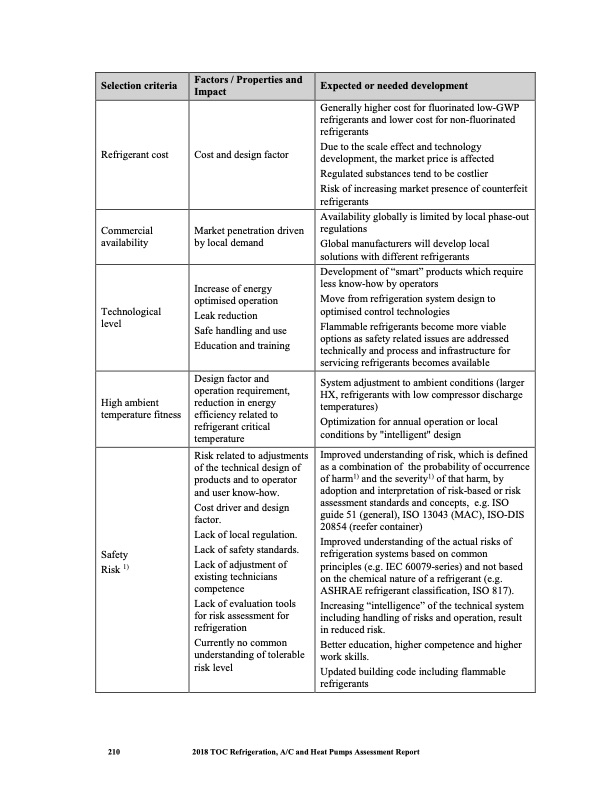
PDF Publication Title:
Text from PDF Page: 223
Selection criteria Factors / Properties and Impact Expected or needed development Refrigerant cost Cost and design factor Generally higher cost for fluorinated low-GWP refrigerants and lower cost for non-fluorinated refrigerants Due to the scale effect and technology development, the market price is affected Regulated substances tend to be costlier Risk of increasing market presence of counterfeit refrigerants Commercial availability Market penetration driven by local demand Availability globally is limited by local phase-out regulations Global manufacturers will develop local solutions with different refrigerants Technological level Increase of energy optimised operation Leak reduction Safe handling and use Education and training Development of “smart” products which require less know-how by operators Move from refrigeration system design to optimised control technologies Flammable refrigerants become more viable options as safety related issues are addressed technically and process and infrastructure for servicing refrigerants becomes available High ambient temperature fitness Design factor and operation requirement, reduction in energy efficiency related to refrigerant critical temperature System adjustment to ambient conditions (larger HX, refrigerants with low compressor discharge temperatures) Optimization for annual operation or local conditions by "intelligent" design Safety Risk 1) Risk related to adjustments of the technical design of products and to operator and user know-how. Cost driver and design factor. Lack of local regulation. Lack of safety standards. Lack of adjustment of existing technicians competence Lack of evaluation tools for risk assessment for refrigeration Currently no common understanding of tolerable risk level Improved understanding of risk, which is defined as a combination of the probability of occurrence of harm1) and the severity1) of that harm, by adoption and interpretation of risk-based or risk assessment standards and concepts, e.g. ISO guide 51 (general), ISO 13043 (MAC), ISO-DIS 20854 (reefer container) Improved understanding of the actual risks of refrigeration systems based on common principles (e.g. IEC 60079-series) and not based on the chemical nature of a refrigerant (e.g. ASHRAE refrigerant classification, ISO 817). Increasing “intelligence” of the technical system including handling of risks and operation, result in reduced risk. Better education, higher competence and higher work skills. Updated building code including flammable refrigerants 210 2018 TOC Refrigeration, A/C and Heat Pumps Assessment ReportPDF Image | Heat Pumps Technical Options

PDF Search Title:
Heat Pumps Technical OptionsOriginal File Name Searched:
RTOC-assessment-report-2018_0.pdfDIY PDF Search: Google It | Yahoo | Bing
CO2 Organic Rankine Cycle Experimenter Platform The supercritical CO2 phase change system is both a heat pump and organic rankine cycle which can be used for those purposes and as a supercritical extractor for advanced subcritical and supercritical extraction technology. Uses include producing nanoparticles, precious metal CO2 extraction, lithium battery recycling, and other applications... More Info
Heat Pumps CO2 ORC Heat Pump System Platform More Info
| CONTACT TEL: 608-238-6001 Email: greg@infinityturbine.com | RSS | AMP |